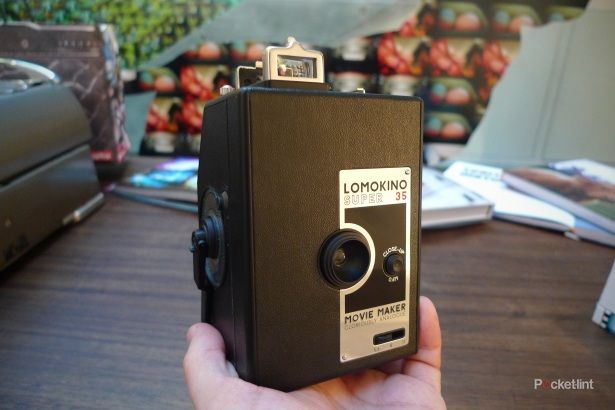Analogue camera specialist Lomography has unveiled its very first movie camera, the LomoKino, and we were invited along to Lomo HQ for a top secret preview prior to the official launch.
As we'd already received an invite to the launch event in the form of an old cinema ticket along with a pack of popcorn, we'd guessed that the new product would be a movie gadget of some sort. However, while most internet rumours pointed towards some form of 8mm movie cam, the LomoKino actually uses good ol' 35mm, which is nice and cheap to buy and easy to find, unlike 8mm cine film.
Equipped with a 25mm lens, the LomoKino takes 4 shots per frame, giving you a total of 144 shots on a roll which, when edited together into a digital movie file, should give you a silent film lasting between 36 and 48 seconds (at around 3-4 frames per second). You can use any type of 35mm film - whether that's conventional colour negative, slide film or black and white - and all you need to do is turn the film crank on the side of the camera to capture your shots. Varying the speed of the crank will determine how slow or fast your film is and you can either take it all in one go, or stop halfway through and pick up "filming" later on, in another location.

The camera is available on its own, or in a bundle with the LomoKinoScope - a small black box into which you can spool your developed slide film, hold up to the light and watch your movie. Obviously, you can also use the device to view other types of 35mm apart from slide film, but your images will appear in negative, rather than positive (as slide film is specifically designed to produce transparencies, rather than prints). Unfortunately, we didn't get a chance to see the LomoKinoScope in action, but we did get our mitts on the camera and it's a beauty.
The modernist black plastic casing has a suitably retro look to it and although not the slimmest gadget in the world, it's certainly small enough to fit into a bag (a fairly spacious bag, granted). And it's also extremely lightweight and fits comfortably in the hand. Although we didn't actually get the chance to shoot a roll, the loading mechanism all appears to be very straightforward, so you should be able to cut your own, hipster-flavoured version of Keystone Cops before you know it.

The rudimentary viewfinder pops up at the flick of a switch and packs down flat for storage. The viewing window is really quite tiny as it's sized to match the quarter frame shots that you'll be taking, so it's a bit of a struggle to see through. However, most users will probably end up sticking to Lomo's "shoot from the hip" ethos and doing away with the viewfinder in favour of freestyle shooting.
The top of the unit is also home to a hotshoe adaptor so that you can attach any compatible flashgun. The experts at Lomography tell us that the Fritz the Blitz flash is the most suitable product from the Lomo range to use with the new model, thanks to its swift power-up time and variable flash setting. The flash will keep firing as long as you keep turning the crank.
The camera has a variable aperture setting which can be adjusted from f/5.6 through f/8 to f/11 using a dial which turns nice and smoothly so that it can be used seamlessly while you're taking snaps. Likewise, the close-up button can be held down while filming to focus on objects up to 0.6m away. When released, the camera goes back to its usual 1m-infinity range. As very little pressure is needed on the button, it should be easy to press during shooting without jogging the camera too much.

Keeping the controls to a bare minimum, the LomoKino also features a rewind dial and a film indicator with a red bar that moves from full to empty as the film is used up. It gives you a rough idea of how much film you have left. There's also a standard tripod mount on the underside of the camera to get rid of the effects created by shaky hands.
Getting your film processed by the LomoLab will get you digital files of each separate frame (24x 8.5mm), along with a digital movie file comprised of all your images. Alternatively you can just get the film scanned and do the digital splicing and editing for yourself. There'll be two processing options - the faster, cheaper (and slightly lower quality) machine scanning method, or the slightly higher priced and higher-res manual scanning, which should also enable you to include sprocket holes on your finished images and film.
You'll be able to upload your videos to the Lomography site as usual, while the company will be promoting Vimeo as the best place to host your videos, which can then easily be embedded on your LomoHome page.
The Lomography LomoKino is available now for £65 (making it one of the cheaper cameras in the Lomo range) or you can get it bundled with the LomoKinoScope for £89. The proof will be in the testing, but this little movie camera certainly looks like a lot of fun and a hell of a lot easier and cheaper than shelling out on an old 8mm camera.
Are you into your Lomo? Or are you now purely digital? Let us know in the comments below...

